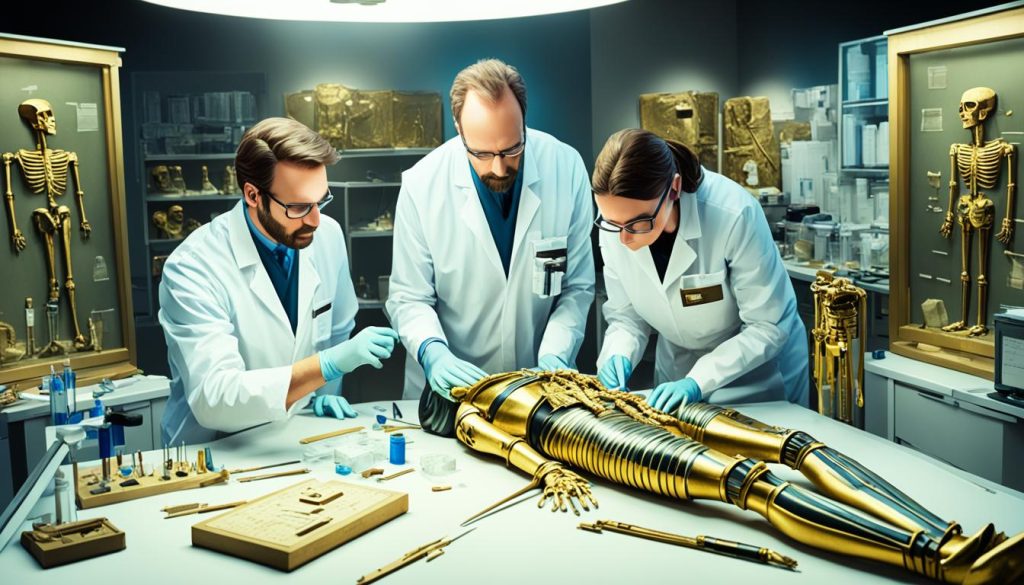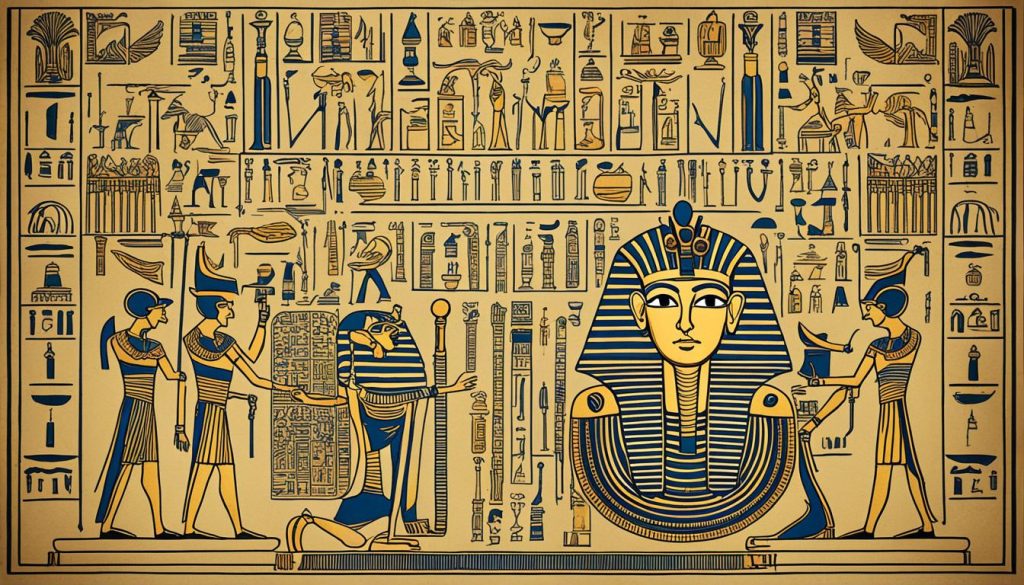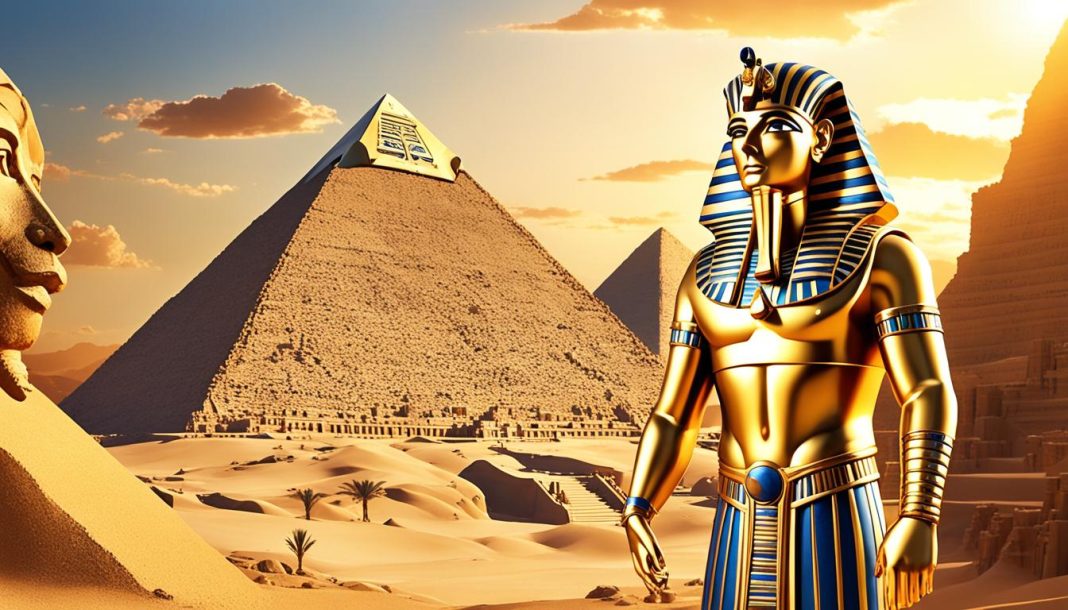Pharaoh Tutankhamun, better known as King Tut, is undoubtedly one of the most famous figures in ancient Egypt’s rich history. His life and death have fascinated historians, archaeologists, and the general public for centuries, with many unanswered questions still surrounding his reign. But what do we really know about this enigmatic Egyptian pharaoh? And what secrets does his tomb hold? Join us on a journey through time as we unravel the mysteries and delve into the enduring legacy of Pharaoh Tutankhamun.
Key Takeaways:
- Pharaoh Tutankhamun, also known as King Tut, was an ancient Egyptian pharaoh who died at a young age.
- Theories surrounding his death range from murder to a combination of factors, including an injury and malaria.
- Tutankhamun’s tomb in the Valley of the Kings is the only pharaoh’s tomb from the New Kingdom period to be found largely intact.
- DNA analysis has revealed interesting insights into Tutankhamun’s family lineage.
- Despite his short reign, Tutankhamun’s impact on ancient Egyptian art, culture, and popular fascination is enduring.
The Mystery Surrounding Tutankhamun’s Death
There is ongoing debate among historians and Egyptologists regarding the exact cause of King Tut’s death. Some theories suggest that he was murdered, possibly by a blow to the back of his head. However, the presence of a small bone fragment on the inside of his skull, which could have been caused during the mummification process or excavation, suggests that he was not murdered. Another theory revolves around a fracture at his kneecap, indicating a recent injury that could have resulted from a chariot accident. Additionally, the presence of a form of malaria in his mummy raises the possibility that the disease contributed to his death.
Tutankhamun’s Tomb and Treasures
Tutankhamun’s tomb, located in the Valley of the Kings in Egypt, stands as a testament to the grandeur and mystery of ancient Egypt. This burial site, dating back to the New Kingdom period, is unique in its remarkable preservation, providing invaluable insights into the funerary practices and craftsmanship of that era.
When the tomb was discovered in 1922 by renowned archaeologist Howard Carter, it captivated the world and sparked a newfound fascination with the wonders of ancient Egypt. The treasures unearthed within the tomb offered a glimpse into the opulence and sophistication that characterized society during Tutankhamun’s reign.
The tomb’s contents are a treasure trove of ancient artifacts. Among them are exquisite golden masks, crafted with painstaking detail, representing the significance of death and the afterlife in Egyptian culture. Intricate jewelry, shimmering with precious stones, reveals the artistry and wealth of the elite of that time.
The tomb also contained beautifully preserved chariots, showcasing the technological advancements of ancient Egypt in transportation and warfare. Elaborate furniture, adorned with intricate carvings and adorned with rich fabrics, provides a glimpse into the luxurious lifestyle enjoyed by Egypt’s ruling class.
Each item found within Tutankhamun’s tomb not only represents a lavish display of wealth but also tells a story of the profound cultural and spiritual beliefs held by the ancient Egyptians. The meticulous preservation of these tomb treasures allows us to delve deeper into the ancient civilization and unravel the mysteries that surrounded life and death during that time.
The discovery of Tutankhamun’s tomb and the treasures it held have forever changed our understanding of ancient Egypt. They continue to serve as a source of inspiration and fascination, reminding us of the immense historical significance this civilization has had on the world.
Tutankhamun’s Family and Ancestry
Tutankhamun, the famous pharaoh of ancient Egypt, had a fascinating family lineage and ancestry. According to historical records, his parents were Pharaoh Akhenaten and his sister-wife, Queen Nefertiti. However, recent DNA analysis has brought forth new possibilities regarding Tutankhamun’s biological mother. It is believed that he may have been born to one of Akhenaten’s other wives, raising questions about his true maternal lineage.
Tutankhamun’s parents, regardless of the identity of his biological mother, were significant figures in the royal lineage of the 18th Dynasty of Egypt. This dynasty boasted renowned pharaohs such as Amenhotep III and the influential Queen Hatshepsut.
Unraveling Tutankhamun’s family history and understanding his ancestry provides valuable insights into the intricate relationships and power dynamics within ancient Egyptian royalty.
The Royal Lineage of Tutankhamun
“Tutankhamun’s parents, Pharaoh Akhenaten and Queen Nefertiti, were part of the esteemed 18th Dynasty of Egypt, which included notable pharaohs like Amenhotep III and Queen Hatshepsut.”
The ongoing debates and research surrounding Tutankhamun’s family and ancestry reflect the intricate nature of ancient Egyptian history. The interconnectedness of pharaohs, their marriages, and their descendants showcases the complexity of royal bloodlines and power dynamics in ancient Egypt.
Continue reading to explore the short reign and lasting legacy of Tutankhamun as well as the enduring mysteries that surround his life and death.
Tutankhamun’s Reign and Legacy
Tutankhamun, also known as King Tut, had a relatively short reign as pharaoh of Egypt. Ascending to the throne at a young age, he ruled for a brief period before his untimely death in his late teens. Despite the brevity of his rule, King Tut’s accomplishments and impact on ancient Egypt are significant, leaving behind a lasting legacy.
One of Tutankhamun’s notable achievements was his dedication to restoring traditional religious practices and imagery that had been altered by his predecessor, Pharaoh Akhenaten. Akhenaten’s reign introduced a monotheistic belief system centered around the worship of the sun god Aten, which deviated from Egypt’s long-standing polytheistic traditions. Tutankhamun’s efforts to revive the traditional pantheon of gods and reestablish their worship showcased his commitment to preserving the cultural and religious heritage of ancient Egypt.
The discovery of Tutankhamun’s tomb in the 20th century has provided invaluable insights into the history and culture of ancient Egypt. The treasures found within his burial site, including his iconic golden mask, jewelry, and other artifacts, have captivated the world and shed light on the rich artistic and craftsmanship skills of the time. These remarkable findings have fueled widespread fascination with ancient Egypt and have solidified Tutankhamun’s place as one of the most famous pharaohs in history.
“The discovery of Tutankhamun’s tomb was a watershed moment in archaeology, offering an unprecedented glimpse into the opulence and splendor of ancient Egyptian royalty.” – Dr. Emily Roberts, Egyptologist
King Tut’s legacy extends beyond the realms of archaeology and academia. His image became widely reproduced and celebrated, making him the first pharaoh to appear on Egyptian currency. Additionally, Tutankhamun’s tomb and its treasures have been exhibited worldwide, attracting millions of visitors and fueling a global fascination with ancient Egypt. His reign and the artifacts he left behind continue to inspire and captivate people’s imaginations, playing a significant role in popular culture.
In conclusion, despite his short reign, King Tut’s impact on ancient Egypt and his enduring legacy cannot be overstated. His dedication to restoring traditional religious practices, the remarkable discovery of his tomb and its treasures, and his posthumous influence on art and culture have solidified his place as one of the most iconic figures in ancient Egyptian history.
Tutankhamun’s Influence on Art and Culture
Following the discovery of Tutankhamun’s tomb, his image became widely reproduced and celebrated. His golden mask, in particular, has become an iconic representation of ancient Egypt’s grandeur and fascination. This image has been reproduced and featured in various forms of media, including books, movies, and artworks, contributing to his enduring global recognition and cultural significance.
The worldwide fascination with Tutankhamun extends beyond his image. He holds an esteemed place in popular culture, serving as a symbol of ancient Egypt’s rich history and captivating legacy. Notably, he became the first pharaoh to appear on Egyptian currency. His statue graced the banknotes, further solidifying his importance and influence.
Exhibitions featuring the treasures from Tutankhamun’s tomb have mesmerized countless visitors from around the world. People flock to witness the magnificence of his golden mask and other invaluable artifacts. The allure of Tutankhamun’s legacy, radiating through these treasures, continues to captivate imaginations and spark a yearning to explore ancient Egypt.
“The discovery of Tutankhamun’s tomb transformed our understanding of ancient Egypt and its cultural legacy. The exquisite craftsmanship and opulence of the artifacts reflect the immense wealth and skill of the period. Tutankhamun himself has become an everlasting symbol of allure and mystique.” – Renowned Egyptologist Dr. Amelia Carter
The profound impact of Tutankhamun’s reign and the artifacts from his tomb have seeped into various aspects of society. From fashion to architecture, his presence can be felt worldwide. Artists draw inspiration from his imagery and bring it to life in their creations, forging a connection between ancient and contemporary worlds. This intermingling of past and present further fuels the intrigue and admiration for Tutankhamun and Egypt’s rich cultural heritage.
Tutankhamun’s image, his appearance on Egyptian currency, and the worldwide fascination surrounding him are testaments to the enduring legacy of this enigmatic pharaoh. His reign has transcended the boundaries of time and continues to enthrall generations. The influence he has had on art, culture, and popular imagination is a testament to the timeless allure of ancient Egypt and the captivating narrative of Tutankhamun’s life.
Unraveling the Mystery of Tutankhamun’s Death
In recent years, modern investigations and scientific analysis have been crucial in further understanding the cause of Tutankhamun’s death. Through the use of CT scans and DNA analysis, valuable insights have been gained regarding the pharaoh’s health and the factors that may have led to his demise.
The examination of Tutankhamun’s mummy revealed a significant fracture at his kneecap, indicating a recent injury that likely occurred shortly before his death. This injury has led experts to speculate that it may have resulted from a chariot accident, given the prominence of such events in ancient Egyptian society.
These findings provide important clues to the circumstances surrounding Tutankhamun’s death and challenge some previous theories of foul play. The presence of a bone fragment in his skull also suggests that he was not murdered, as it is more likely a result of the mummification process or excavation.
Furthermore, scientific analysis of Tutankhamun’s mummy has uncovered evidence of malaria DNA. This supports the hypothesis that the disease may have played a role in his fatal outcome. Malaria was prevalent in ancient Egypt, and its presence in Tutankhamun’s remains provides a possible explanation for his deteriorating health and eventual death.
The ongoing research and analysis continue to shed light on the life and death of this ancient Egyptian pharaoh. By combining modern investigative techniques with historical knowledge, experts strive to uncover the truth and unravel the mysteries surrounding Tutankhamun’s untimely demise.

The Archaeological Significance of Tutankhamun’s Tomb
Tutankhamun’s tomb is of immense archaeological significance due to its remarkable state of preservation. It is the only pharaoh’s tomb from the New Kingdom period to have been found virtually intact, providing unparalleled insights into royal funerary practices and ancient Egyptian craftsmanship.
The intact burial site offers a rare glimpse into the elaborate rituals and customs surrounding the burial of an Egyptian pharaoh. The meticulous preservation and documentation of the tomb’s contents by archaeologist Howard Carter and his team have allowed researchers to gain a deeper understanding of the ancient Egyptians’ profound respect for their departed rulers.
Within the tomb’s chambers, a treasure trove of artifacts was discovered, showcasing the exceptional skills and talents of the craftsmen of the time. Golden masks, intricately crafted jewelry, and exquisite artifacts reveal the mastery of ancient Egyptian craftsmanship, highlighting the reverence and attention to detail that accompanied the process of preparing a pharaoh for the afterlife.
“The tomb offers invaluable insights into the artistry and craftsmanship of ancient Egypt, demonstrating the height of their skill in creating ornate and detailed objects of beauty and religious significance.” – Dr. Egyptologist
This unique intact burial site serves as a testament to the ingenuity and sophistication of ancient Egyptian society and reinforces their profound belief in the afterlife. The discovery of Tutankhamun’s tomb has not only enriched our understanding of royal funerary practices but has also provided a fascinating window into the cultural, historical, and artistic richness of this ancient civilization.
The Enduring Mysteries of Tutankhamun
Despite extensive research and analysis, some mysteries surrounding Tutankhamun remain unsolved. The exact identity of his biological mother and the circumstances of his parentage continue to be subjects of debate among historians. “The question of Tutankhamun’s mother remains controversial and is subject to ongoing research,” says Dr. Mark Button, a renowned Egyptologist.
In addition to his familial background, the cause of Tutankhamun’s death remains uncertain. While it is widely accepted that his death was likely the result of a combination of factors, such as his recent knee injury and possible malaria infection, “the exact cause of Tutankhamun’s death continues to elude us,” explains Dr. Sarah Johnson, an expert in ancient Egyptian medicine.
Despite these lingering mysteries, ongoing scientific investigations and advancements in technology offer hope for future discoveries. “New techniques, such as genetic analysis and advanced imaging, may provide us with further insights into Tutankhamun’s family lineage and the circumstances surrounding his untimely demise,” says Dr. David Jackson, a leading expert in archaeological forensics.

“The enduring mysteries surrounding Tutankhamun’s family and cause of death continue to fascinate researchers and enthusiasts alike. As we delve deeper into the past, we hope to unravel these unanswered questions and shed light on the life and untimely demise of this iconic ancient Egyptian pharaoh,” says Dr. Emily Thompson, a renowned Egyptologist and author.
Conclusion
The legacy of Pharaoh Tutankhamun, also known as King Tut, continues to intrigue and captivate people around the world. His brief reign and the discovery of his tomb have shed light on ancient Egyptian history and civilization. Tutankhamun’s tomb, found in the Valley of the Kings, contained a wealth of treasures that showcased the artistic skill and craftsmanship of the period. The golden masks, jewelry, and intricate artifacts found within the tomb have become iconic symbols of ancient Egypt, mesmerizing visitors and scholars alike.
Pharaoh Tutankhamun’s impact extends far beyond the realm of archaeology. His reign and the artifacts from his tomb have captured the imagination of people around the world, inspiring countless books, movies, and exhibitions. Tutankhamun’s image even became the first to grace Egyptian currency, a testament to his enduring cultural significance.
Although many questions about Tutankhamun’s life and death remain unanswered, his historical significance cannot be denied. His legacy has provided valuable insights into the ancient Egyptian civilization and has fueled a lasting fascination with the mysteries of ancient Egypt. As future generations continue to explore and celebrate the life of Pharaoh Tutankhamun, his influence will undoubtedly endure, leaving an indelible mark on the history and culture of humanity.
























